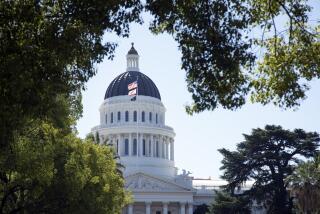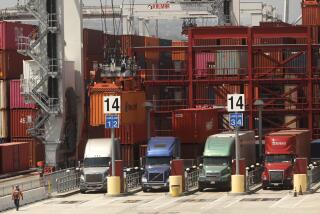Op-Ed: How California’s smog alert system could be adapted to fight the coronavirus
California can manage the coronavirus by adapting a public health tool it pioneered — smog alerts. They have long been used to reduce the health consequences of air pollution, and instituting a system of “virus alerts” could do the same to regulate COVID risk by automatically reinstating shelter-in-place orders when infection or death rates get too high.
Epidemiologists predict that the virus can be contained but not eliminated. Some would have us shelter in place indefinitely. But lockdowns without a foreseeable end will ruin us. Putting a virus-alert system in place would reduce the danger of reopening the economy too early.
A cold-eyed reckoning is coming, in which leaders have to decide what risks are tolerable and how to limit them. We need to accept that COVID risk will be with us for some time. The goal is to manage that risk, not eliminate it.
Fortunately, when California faced these kinds of decisions in the past, it made sensible choices.
In the especially deadly 2017-18 flu season, about 56,000 people died from influenza in the U.S., including 6,900 in California. Hospitals erected tents outside emergency rooms and diverted ambulances to less-impacted facilities. Despite the death toll, no state or national lockdowns were imposed. This loss of life was implicitly considered acceptable.
In 1972, national motor vehicle fatalities peaked around 55,000 annually, and they remain high today. About 40,000 people died in car crashes in 2018, with more than 3,600 of those deaths in California. A draconian ban on all vehicular traffic could have saved these lives. Instead, this loss of life is tolerated as a necessary risk, while governments work to improve the safety of automobiles, enforce drunk driving laws and mandate the use of seat belts.
Similar measures could work against COVID-19 once shelter-in-place orders drive death rates down to what is considered a bearable level. The state economy could start to reopen in counties where death rates are relatively low. People could return to work while observing reasonable safety rules, such as wearing masks in public places and practicing social distancing in restaurants and workplaces.
If deaths caused by COVID-19 start spiking again, that would trigger virus alerts just as increased smog triggers smog alerts. Smog alerts come in three stages of increased severity with increasing restrictions on activity. The last Stage 3 smog alert in California was in 1974 when smog was so bad that Gov. Ronald Reagan urged residents to “limit all but absolutely necessary auto travel.”
Similarly, virus-alert thresholds could be established, when necessary, in localities around the state.
A Stage 1 alert might mean that people over 65 should stay home, and a Stage 2 might direct those with underlying health conditions to stay home as well. The highest alert, a Stage 3, might be activated when a community’s average daily death rate from COVID-19 rises for three days above a 55,000 annual national threshold — adjusted for population — a level close to what we experience with bad seasonal flu.
Counties could reinstitute shelter-in-place ordinances and call for social distancing until the death rate falls below the threshold for a sustained period, perhaps two weeks.
As of early April, California was averaging 45 COVID-19 deaths a day, placing it above that theoretical Stage 3 virus alert level. But eventually it will fall below. When it does — and if virus alerts are in place — Californians could go back to work on a county-by-county basis.
That doesn’t mean life would return to the way things were in the pre-coronavirus era, since that could lead to a sharp rebound in infections. Instead, just as it’s the law to wear a seat belt, as a general rule everyone should be required to wear masks in public and avoid shaking hands. Public service campaigns should keep reminding us to wash our hands, just as they do now to remind us to avoid texting while driving. And, testing, contact tracing and quarantining the sick remain vital.
By taking these steps, many California counties might never need to call a virus alert. And if they did, their lockdowns have a good chance of being short.
During Stage 3 virus-alert lockdowns, death rates may keep rising for a while because deaths are a lagging indicator of how many people are infected. But if periods of work involve requirements such as masks, social distancing and no shaking of hands, the rate of growth should not be ferocious. And once we have reliable random testing to gauge the infection rate by county, we could switch the trigger for calling alerts from deaths to infections, which would work more quickly to keep the disease from spreading.
To get the state’s economy back on its feet, California needs to establish a tolerable level of risk for dealing with the coronavirus and be able to monitor and enforce that standard. A system of virus alerts could help us all get back to work.
Aaron Edlin is a professor of economics and law at UC Berkeley. Dana Goldman is the director of the Schaeffer Center for Health Policy and Economics at USC.
More to Read
A cure for the common opinion
Get thought-provoking perspectives with our weekly newsletter.
You may occasionally receive promotional content from the Los Angeles Times.






